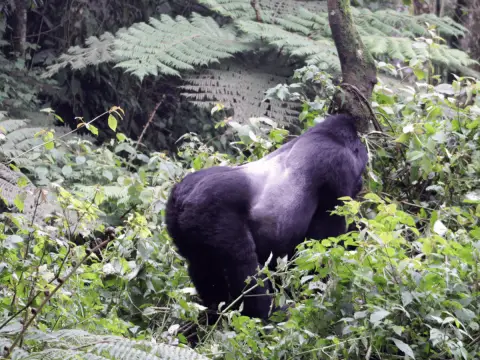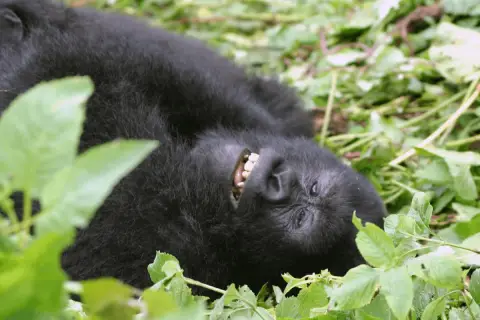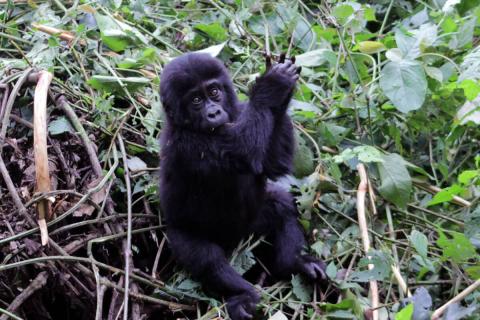Gorillas, these magnificent creatures that share about 98% of our DNA, have long fascinated researchers and nature enthusiasts alike.
From the pictures and videos, you can see a resemblance to humans but this is nothing compared to when you see them with your own eyes - in close proximity. Standing a few feet from a group of gorillas, seeing the emotion in their eyes, hearing their grunts (and the occasional fart), so many questions come to mind.

Questions about what they like to eat, what they do all day, and how they sleep for rest.
In this article, we'll dig deep into how gorillas sleep and the vital implications of a good night's sleep for gorillas.
How Gorillas Sleep
Gorillas sleep for about 13 to 15 hours per day, much like humans. They construct new nests nightly out of leaves and branches, ensuring comfort, and safety from predators as well as maintaining hygiene.
In the afternoon, before sundown, the dominant silverback of the gorilla family leads the rest of the group to a final eating location where the gorillas will also sleep for the night. Their sleeping nest are built early when they have monitored that there is no danger in the area.

Mothers with infants will make a nest to fit them and their infants while every other gorilla will make their sleeping nests out of leaves and shrubbery.
During sleep, gorillas exhibit human-like behaviours, including snoring and shifting positions. These intricate rituals emphasize their intelligence and social nature.
Gorilla Sleep Patterns
Gorillas, much like humans, have distinct sleep patterns. Unlike us, however, gorillas tend to sleep for around 13 to 15 hours per day. This extended rest period is essential for their physical well-being and mental acuity.
Gorillas experience different sleep stages, including REM (Rapid Eye Movement) and non-REM sleep, which are crucial for their overall health.

Sleeping Nests And Behaviors
Gorillas exhibit interesting behaviours related to sleep. Each night, they construct new nests out of leaves and branches. This nightly ritual serves several purposes, primarily ensuring safety from predators and maintaining hygiene.
These nests are carefully crafted, highlighting the gorillas’ intelligence and resourcefulness.
While sleeping, gorillas, like us, may snore and shift positions, indicating their similarities with human sleep behaviours. It is also likely that some gorillas are light sleepers with others being deep sleepers - again, just like us.
Threats To Gorilla Sleep
There are numerous threats to good sleep for gorillas. Unfortunately, most of these are human-driven factors. Habitat loss especially through deforestation leads to increased stress levels, which is not good for sleep and rest.

Additionally, tourism, while offering economic and conservation benefits, often intrudes on gorilla territories, causing disruptions in their natural way of life.
Such disturbances can lead to heightened anxiety, affecting their sleep quality and well-being. This is why gorilla tourism is a carefully implemented activity with more rules than most wildlife engagements.
Gorilla Sleep And Primate Research
The study of gorilla sleep provides valuable insights into primate cognition and behaviour. Observing their sleep patterns helps researchers understand the complexities of primate minds, offering glimpses into the emotional and social aspects of their lives.
Furthermore, research on gorilla sleep contributes significantly to the broader field of sleep science, providing comparative data that enhances our comprehension of sleep across various species, including humans.
Final Thoughts
In the same way, sleep is a very important part of our natural human activity, gorillas do need their sleep. By looking deep into gorillas and their sleep, we get to appreciate the delicate balance of life in their natural home.
From the construction of nightly sleeping nests, the impact of human disruptions and the possibility of them dreaming as humans do, gorilla sleep is both a clever and interesting natural activity.
Understanding how gorillas sleep gives an informed insight into much of the conservation work and how it directly influences the tourism of gorillas and other primates. Now you know why a limited number of people is allowed each day - and for a limited time.
With this knowledge, you can contribute towards their conservation and continued research through tourism or directly working with the people doing conservation and research.
